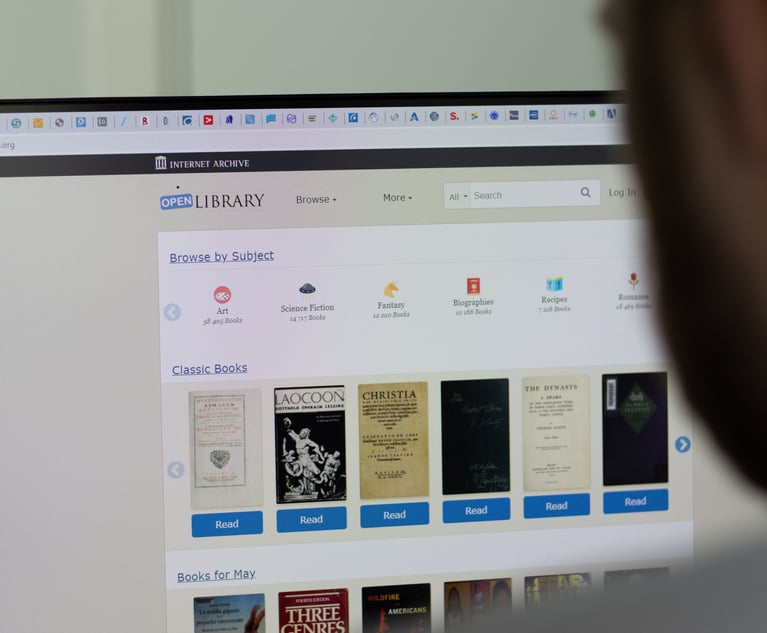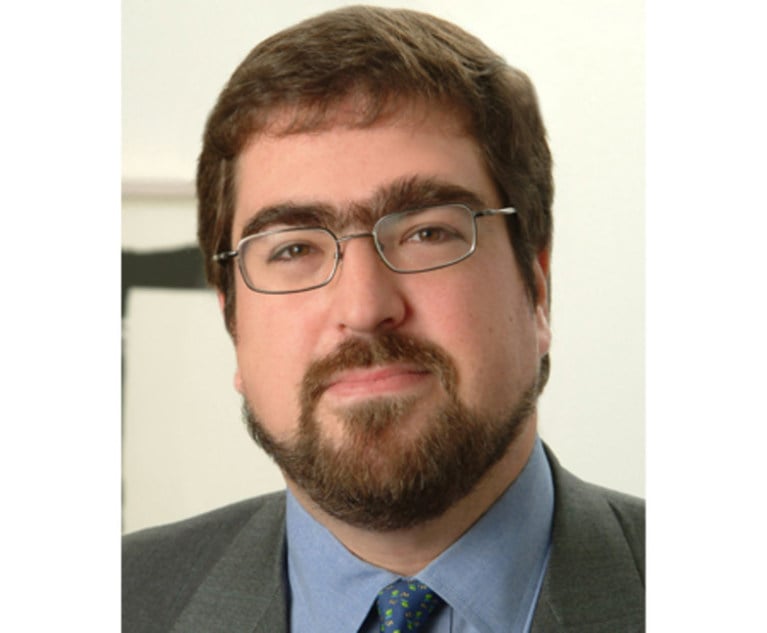Drake Infringement Case: Fair Use as a Matter of Law
In his Intellectual Property column, Stephen M. Kramarsky writes: Though once chaotic, the legal environment for sampling (at least in the U.S. music industry) has settled into a well-understood legal regime, with rigorous clearance and licensing practices becoming the industry norm. Nevertheless, as a recent case involving musician Drake shows, there are always edge cases, and litigation does arise. With the meteoric rise of shared and repurposed content in social media and other digital contexts, those cases are likely to be more and more common.
July 17, 2017 at 02:03 PM
10 minute read
By Stephen M. Kramarsky
One of the thorniest questions faced by intellectual property lawyers advising clients on copyright matters is what constitutes “fair use” of a protected work. With the explosive growth of user-generated content, the artistic ideas of sampling, repurposing and appropriation have become common in broader contexts, and the social media economy is, to a certain extent, built on the idea that works gain value as they are shared and commented on. But the rights of content creators must also be protected if those communities are to continue to exist. Lawyers and judges called on to examine and balance these issues tend to fall back on familiar tools, and for the last 20 years or so, the touchstone of fair use analysis has been a concept that does not actually appear in the Copyright statute: the question of whether the use is “transformative.”
Transformative use analysis can be particularly challenging when it comes to art and artistic commentary. Comparing artistic works—and balancing their contextual similarities and differences—can be challenging, sometimes with the result that “courts knowingly or inadvertently rely on aesthetic theories of interpretation.” Robert Kirk Walker & Ben Depoorter, “Unavoidable Aesthetic Judgments in Copyright Law: A Community of Practice Standard,” 109 NW. U.L. REV. 343, 368 (2015). While it may seem surprising that a court would undertake that sort of aesthetic analysis, particularly on summary judgment, that is exactly what is called for by the current law of fair use. It is easy to forget that the U.S. Supreme Court's 1994 opinion in Campbell v. Acuff-Rose, 510 U.S. 569 (1994), a landmark in fair-use law, was also a landmark in hip-hop, with 2 Live Crew and Roy Orbison squaring off before the court. The doctrine and the genre have been intertwined ever since. For example, in 2003, Judge Gerard Lynch of the Southern District of New York ruled that fair use protected a song by Ghostface Killah, a member of rap's iconic Wu-Tang Clan, that began with an off-key rendition of the classic song “What a Wonderful World.” Judge Lynch observed that Ghostface had not merely parodied the song, he used it to set up a “contrast between the assertedly delusional innocence of mainstream culture and the purportedly more realistic viewpoint of the rapper.” Abilene Music v. Sony Music Ent., 320 F. Supp. 2d 84, 91 (S.D.N.Y. 2003). This, the court ruled, was transformative.
Similar (if less dark) issues informed the court's recent analysis in Estate of Smith v. Cash Money Records. There, the court again addressed the question of when an artist is protected even though he indisputably uses portions of a copyrighted work. Judge William Pauley III's discussion of transformative use in that case is worth a closer look: It is interesting and informative not only from a legal point of view, but from an aesthetic and philosophical one.
Drake Gets Sued
In 2014, the estate of jazz legend Jimmy Smith brought an action for copyright infringement against the hugely popular Canadian musician Aubrey Drake Graham—yes, that's Drake—and several companies involved in the recording, production, marketing and distribution of the song “Pound Cake/Paris Morton Music 2″ (Pound Cake) from his 2013 album “Nothing Was the Same.” See generally Complaint, Estate of Smith v. Cash Money Records, No. 1:14-cv-02703 (WHP) (S.D.N.Y. April 16, 2014), ECF No. 2. The suit alleged that Drake impermissibly copied about 35 seconds of a minute-long spoken-word recording from Smith's 1982 album “Off the Top” entitled “Jimmy Smith Rap” (JSR) for use in Pound Cake.
This content has been archived. It is available through our partners, LexisNexis® and Bloomberg Law.
To view this content, please continue to their sites.
Not a Lexis Subscriber?
Subscribe Now
Not a Bloomberg Law Subscriber?
Subscribe Now
NOT FOR REPRINT
© 2024 ALM Global, LLC, All Rights Reserved. Request academic re-use from www.copyright.com. All other uses, submit a request to [email protected]. For more information visit Asset & Logo Licensing.
You Might Like
View All

Not All Secrets Are Trade Secrets: SDNY Examines the Limits of NDA Protection
13 minute read
'Rampant Piracy': US Record Labels File Copyright Suit Against French Distributor Believe
5 minute readTrending Stories
- 1Call for Nominations: Elite Trial Lawyers 2025
- 2Senate Judiciary Dems Release Report on Supreme Court Ethics
- 3Senate Confirms Last 2 of Biden's California Judicial Nominees
- 4Morrison & Foerster Doles Out Year-End and Special Bonuses, Raises Base Compensation for Associates
- 5Tom Girardi to Surrender to Federal Authorities on Jan. 7
Who Got The Work
Michael G. Bongiorno, Andrew Scott Dulberg and Elizabeth E. Driscoll from Wilmer Cutler Pickering Hale and Dorr have stepped in to represent Symbotic Inc., an A.I.-enabled technology platform that focuses on increasing supply chain efficiency, and other defendants in a pending shareholder derivative lawsuit. The case, filed Oct. 2 in Massachusetts District Court by the Brown Law Firm on behalf of Stephen Austen, accuses certain officers and directors of misleading investors in regard to Symbotic's potential for margin growth by failing to disclose that the company was not equipped to timely deploy its systems or manage expenses through project delays. The case, assigned to U.S. District Judge Nathaniel M. Gorton, is 1:24-cv-12522, Austen v. Cohen et al.
Who Got The Work
Edmund Polubinski and Marie Killmond of Davis Polk & Wardwell have entered appearances for data platform software development company MongoDB and other defendants in a pending shareholder derivative lawsuit. The action, filed Oct. 7 in New York Southern District Court by the Brown Law Firm, accuses the company's directors and/or officers of falsely expressing confidence in the company’s restructuring of its sales incentive plan and downplaying the severity of decreases in its upfront commitments. The case is 1:24-cv-07594, Roy v. Ittycheria et al.
Who Got The Work
Amy O. Bruchs and Kurt F. Ellison of Michael Best & Friedrich have entered appearances for Epic Systems Corp. in a pending employment discrimination lawsuit. The suit was filed Sept. 7 in Wisconsin Western District Court by Levine Eisberner LLC and Siri & Glimstad on behalf of a project manager who claims that he was wrongfully terminated after applying for a religious exemption to the defendant's COVID-19 vaccine mandate. The case, assigned to U.S. Magistrate Judge Anita Marie Boor, is 3:24-cv-00630, Secker, Nathan v. Epic Systems Corporation.
Who Got The Work
David X. Sullivan, Thomas J. Finn and Gregory A. Hall from McCarter & English have entered appearances for Sunrun Installation Services in a pending civil rights lawsuit. The complaint was filed Sept. 4 in Connecticut District Court by attorney Robert M. Berke on behalf of former employee George Edward Steins, who was arrested and charged with employing an unregistered home improvement salesperson. The complaint alleges that had Sunrun informed the Connecticut Department of Consumer Protection that the plaintiff's employment had ended in 2017 and that he no longer held Sunrun's home improvement contractor license, he would not have been hit with charges, which were dismissed in May 2024. The case, assigned to U.S. District Judge Jeffrey A. Meyer, is 3:24-cv-01423, Steins v. Sunrun, Inc. et al.
Who Got The Work
Greenberg Traurig shareholder Joshua L. Raskin has entered an appearance for boohoo.com UK Ltd. in a pending patent infringement lawsuit. The suit, filed Sept. 3 in Texas Eastern District Court by Rozier Hardt McDonough on behalf of Alto Dynamics, asserts five patents related to an online shopping platform. The case, assigned to U.S. District Judge Rodney Gilstrap, is 2:24-cv-00719, Alto Dynamics, LLC v. boohoo.com UK Limited.
Featured Firms
Law Offices of Gary Martin Hays & Associates, P.C.
(470) 294-1674
Law Offices of Mark E. Salomone
(857) 444-6468
Smith & Hassler
(713) 739-1250







